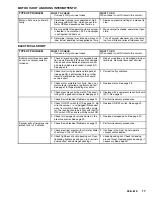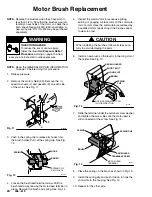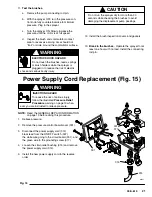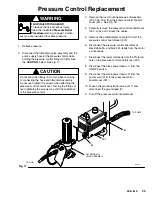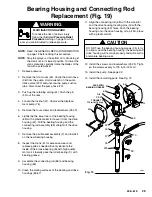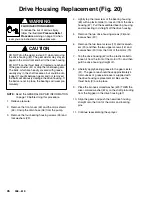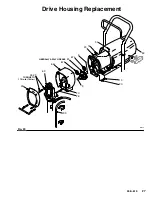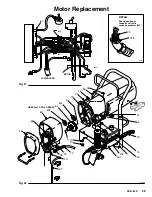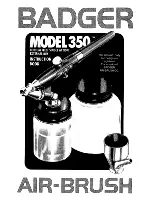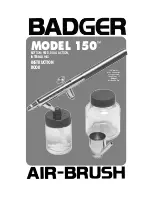
14
308-619
MOTOR WON’T OPERATE (Continued)
TYPE OF PROBLEM
WHAT TO CHECK
If check is OK, go to next check
WHAT TO DO
When check is not OK refer to this column
Follow
Pressure Relief
Procedure on
page 13.
Remove gun from hose.
Remove pressure control.
1
. Check leads from motor to be sure they are
securely fastened and properly mated.
1. Replace loose terminals; crimp to leads. Be
sure male terminal blades are straight and
firmly connected to mating part.
Clean circuit board male terminals. Re-
place loose or damaged terminals. Se-
curely reconnect leads.
2. Check for loose motor brush lead connections
and terminals. See page 20.
2. Tighten terminal screws. Replace brushes
if leads are damaged. See page 20.
3. Check brush length which should be 1/2” mini-
mum. See page 20.
NOTE:
The brushes do not wear at the same
rate on both sides of the motor . Check both
brushes.
3. Replace brushes. See page 20.
4. Check for broken or misaligned motor brush
springs. Rolled portion of spring must rest
squarely on top of brush. See page 20.
4. Replace spring if broken. Realign spring
with brush. See page 20.
5. Check motor brushes for binding in brush
holders. See page 20.
5. Clean brush holders. Remove carbon with
small cleaning brush. Align brush leads
with slot in brush holder to assure free verti-
cal brush movement.
6. Check motor armature commutator for burn
spots, gouges and extreme roughness. Re-
move motor cover and brush
inspection
plates to check. See page 20.
6. Remove motor and have motor shop resur-
face commutator if possible. See page 28.
7. Check motor armature for shorts using arma-
ture tester (growler) or perform spin test. See
page 18.
7. Replace motor. See page 28.
8. Check pressure control board (301) by substi-
tuting with a good pressure control board. See
page 23.
8. Replace with new pressure control board
(301). See page 23.
Refer to the wiring diagram
on page 38 to identify test
points (TP).
1. Check power supply cord (314). Disconnect
TP1 female (neutral) and TP2 female and
connect volt meter to these leads. Plug in
sprayer. Meter should read 105 to 125 V AC.
Unplug sprayer. Reconnect TP2.
1. Replace power supply cord. See page 21.
2. Check ON/OFF switch (307). Disconnect TP3
and connect volt meter to TP1 female and TP3
male terminal on the ON/OFF switch. Plug in
sprayer and turn ON. Meter should read 105
to 125 VAC. Turn off and unplug sprayer. Re-
connect TP3.
2. Replace ON/OFF switch. See page 22.
3. Check motor terminal cutoff switch. Connect
volt meter to TP1 female and TP4 female.
Plug in sprayer and turn on. Meter should read
105 to 125 VAC. Turn off and unplug sprayer.
3. Allow motor to cool. Correct cause of over-
heating. If switch remains open after motor
cools, check continuity between TP4 fe-
male and TP5 female with ohmmeter . If
open, replace motor.
4. Check all terminals for damage or loose fit.
Reconnect TP1, TP4, and TP5 connectors.
4. Replace damaged terminals and recon-
nect securely.

















